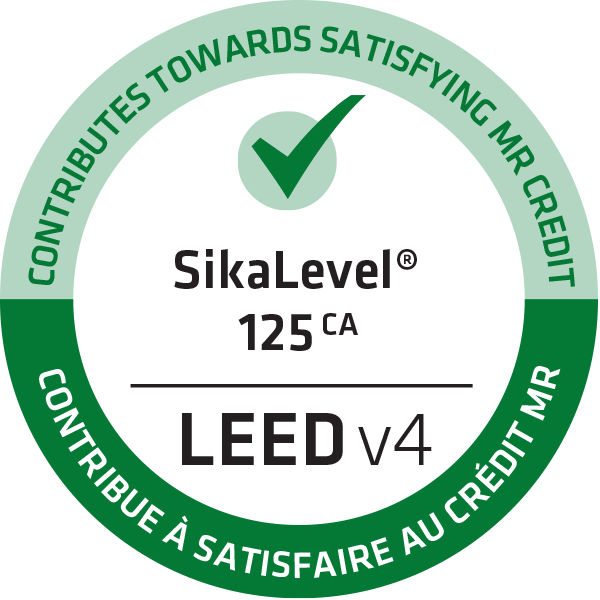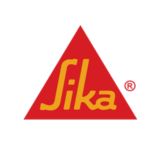
Sika® Level-125
Polymer-Modified and Sika® ViscoCrete® Improved, Self-Levelling Cementitious Underlayment for Use from 1 to 38 mm (1/25 to 1 1/2 in) Thickness
- Easy and quick to install.
- Zero VOC content and low odour.
- Highly fluid and self-levelling.
- Manual or pumpable application.
- Feather-edging acceptable in pedestrian areas.
- Levels new and renovates old floors.
- Rapid drying, can be walked on after 4 hours at 23°C (73°F).
- Ceramic tiles and natural stone can be installed after 24 hours.
- Floor coverings (carpet, vinyl, PVC, rubber, engineered wood flooring) can be installed after 1 to 3 days.
- Suitable on floors with in-floor radiant heating.
- Excellent underlayment for tiles, sheet products and wood floor bonding systems.

Usage
Interior floor levelling and smoothing applications in pedestrian areas, where floor coverings are to follow, such as:
- Institutional - schools, colleges, hospitals, clinics, libraries, galleries, museums.
- Commercial - offices, corridors, hallways, canteens, cafeterias, stores, hotels, restaurants.
- Residential - domestic properties, condominiums and high rise construction.
Advantages
- Easy and quick to install.
- Zero VOC content and low odour.
- Highly fluid and self-levelling.
- Manual or pumpable application.
- Feather-edging acceptable in pedestrian areas.
- Levels new and renovates old floors.
- Rapid drying, can be walked on after 4 hours at 23°C (73°F).
- Ceramic tiles and natural stone can be installed after 24 hours.
- Floor coverings (carpet, vinyl, PVC, rubber, engineered wood flooring) can be installed after 1 to 3 days.
- Suitable on floors with in-floor radiant heating.
- Excellent underlayment for tiles, sheet products and wood floor bonding systems.
Packaging
22.7 kg (50 lb) bag
Colour
Concrete Grey
FAQ
Yes, it’s suitable on floors with in-floor radiant heating.
Sika® Level-125 is for interior use only and not suitable for slopes or inclines > 0.5 %
If subsequent layers of Sika® Level-125 are installed on existing cured Sika® Level-125, mechanical preparation and re-priming is required.
Sika® Level-125 does not provide an aesthetic finish and is intended to receive a covering. The Sika® Level-125 cannot be overcoated with a resin other than Sika® Primer MB. And when overcoating with Sika® Primer MB, mechanical preparation may be required to remove all surface laitance and material which could interfere with adhesion.
Ceramic tiles and natural stone can be installed after 24 hours and Floor coverings (carpet, vinyl, PVC, rubber, engineered wood flooring) can be installed after 1 to 3 days.
Avoid walking on the underlayment for at least 4 hours and do not expose to rolling dynamic loads for 3 days, at +23 °C (73 °F) and 50 % R.H.
Sika® Level-125CA must be allowed to air cure. Do not wet cure or use curing and sealing compounds.
For thin section works, for example < 6 mm (1/4 in) thickness, it may be advisable to apply by a combination of trowel and pin rake (CAM® type or similar) as flow and self-levelling characteristics can be impacted at reduced thicknesses. Over large areas, application by conventional piston, rotor-stator or underlayment type pumps may be more appropriate. Though not necessary owing to the high flow properties of the material, spike rolling in two directions (90°) to remove installation marks and any entrapped air can be undertaken but avoid overworking. Note: Where required to establish the appropriate method of application, the acceptability of workmanship and the nature of finish, jobsite trials are recommended.
Prior to placing the underlayment, ensure that all sources of premature drying or direct sunlight are blocked off to avoid accelerated curing and reduced physical properties. The stated ambient and substrate application temperatures are to be achieved before installation and should be maintained for a period of at least 3 days thereafter. Should colder conditions prevail, make allowances for the use of indirect and vented heaters to achieve and maintain the application temperatures required. Where temperatures exceed +30 °C (86 °F), refer to and follow ACI hot weather application and protection guidelines.
Before laying the material, organize labour to operate most effectively, ensuring that installers can maintain a continuous flow of material and avoid creating cold joints. The dimensions of the pour, in terms of width, should also be set accordingly.
Sika® Level-125CA must not be applied in such a way that expansion and control joints in the substrate are bridged; such joints must be detailed through the underlayment. Provide for expansion and control joints where specified, including at the perimeter of rooms, columns, and pedestals. Should such joints not exist in the substrate, they should still be provided for in the underlayment. Joints, of at least 6 mm (1/4 in) can be formed using foam tape at the time of laying or can be cut into Sika® Level-125CA within 24 hours of application.
Quickly and without delay, pour or pump the mixed material onto the primed surface in a ribbon pattern, ensuring that a wet edge is maintained; spread by trowel or pin rake (CAM® type or similar) to the required thickness [minimum 1 mm (1/25 in), maximum 38 mm (1 1/2 in)] achieving the necessary coverage over high points.
When pump-mixing, employ the 4.1 L (1.08 US gal.) to 22.7 kg (50 lb) water to powder ratio within a continuous mixer and pump, or a batch mixer and pump, ensuring that the mechanical mixers and pumps are in sound working order. Preclean and test the equipment, checking that the mixing and pumping elements are fully functional and that meshes are in place to prevent foreign matter from entering the hopper or being dispensed onto the floor.
Pour 3.9 to 4.1 L (1.04 to 1.08 US gal.) of cool, potable water into a suitably sized and clean mixing container, using a calibrated measuring jug, or similar, to ensure strict control of the water content (avoid overwatering). Cool water (21 °C/70 °F) serves to maximize the working time; if available water is not at this temperature, then consideration should be given to cooling the water. Add Sika® Level-125CA to the water, while slowly stirring, adding the complete contents of the 22.7 kg (50 lb) bag. Once all the powder has been added, continue mixing until a lump-free and uniform consistency is achieved.
If mixing in a barrel or similar container, employ the water to powder ratio as stated above and use a low-speed electric mixer (300 to 450 r pm) with an Eggbeater style mixing paddle (recommended model) to blend water and powder for a minimum of three (3) minutes, until a uniform mix has been produced. Do not overmix or allow the paddle to rise above the level of material as this will introduce and entrap air into the mortar, potentially shortening the working life or causing pin-holing in the underlayment. Let the mixed material stand until most air bubbles have dispersed
When installing Sika® Level-125 underlayment over wooden subfloors, ensure that the subfloor consists of at least two layers of exterior grade plywood (CANPLY compliant), a minimum of 32 mm (1 1/4 in) in thickness and meets, as a minimum, the deflection parameters of L/360 (live and dead loads taken into consideration). The wood/plywood must then be suitably secured, bonded, and prepared to a contaminant free and sound condition. Refer to the manufacturer of the final floor covering regarding the deflection requirements of the floor finish system.
Careful consideration should be given to the selection of the method of mechanical surface preparation and the timing of application of primer and underlayment. Immediately following mechanical preparation on some excessively porous substrates, outgassing will increase for a short period of time (approx. 48 hours) until an equilibrium in slab vapour pressure and the ambient environment is reached. Before overall installation begins, Sika Canada recommends the application of several small test patches to determine primer application requirements and acceptability of final product performance. In general, a one-coat application of Sika® Level Primer should be sufficient; however, allowance should be made for double priming on excessively porous substrates (except for Sika® Level-03CA Primer which is a single coat application only). Where multiple coats are required, do not apply excessive material.
Prepare concrete, cement, and dense substrates, including ceramic, quarry, and vinyl tiles by mechanical means to achieve an open-textured, fine gripping surface (ICRI - CSP 3 minimum). Weak concrete should be removed and surface defects such as blowholes and spalls fully exposed and repaired with repair materials such as Sika® Level SkimCoatCA (depending upon depth) prior to priming and levelling. All cracks and holes should be similarly filled to prevent seepage of the primer through to lower areas. Contact Sika Canada for recommendations.
All loose friable material, including preparation residue, must be completely removed using a vacuum before application of Sika® Level Primers. The compressive strength of substrates should be at least 20 MPa (2900 lb/po2) at 28 days with a minimum tensile strength of 1 MPa (145 lb/po2) at the time Sika® Level Primers are applied. Moisture Vapour Emission Rates of the substrate should comply and meet the requirements of the proposed floor covering. Please consult the manufacturer of the final floor finish for advice.
All concrete and cement substrates must be primed using Sika® Level-01 PrimerCA, or where concrete/cement and wood substrates exist, Sika® Level-03 PrimerCA may be used. The substrates must be dry, clean, and stable before priming and applying the underlayment. Remove all existing treatments such as coatings, sealers, wax, latex compounds, impregnations and curing agents, together with all contaminants, i.e., dirt, dust, laitance, grease, oils, and foreign matter, which will interfere with the penetration of Sika® Level-01 PrimerCA or Sika® Level-03 PrimerCA.
13.4 L (3.5 US gal) per 22.7 kg (50 lb) bag approx.
Approximate coverage at typical thicknesses per 22.7 kg (50 lb) bag
- 1 mm (1/25 in) yields 13.2 m2 (142 ft2)
- 5 mm (3/16 in) yields 2.6 m2 (28 ft2)
- 10 mm (3/8 in) yields 1.3 m2 (14 ft2)
- 16 mm (5/8 in) yields 0.8 m2 (8.6 ft2)
- 25 mm (1 in) yields 0.5 m2 (5.3 ft2)
- 38 mm (1 1/2 in) yields 0.3 m2 (3.8 ft2)
Typical application thickness is 1 to 38 mm (1/25 to 1 1/2 in)
Ambient and surface temperatures at the time of application are between +10 °C (50 °F) minimum and +35 °C (95°F) maximum.
For best results, condition product to +18 to +29 °C (65 to 84 °F) prior to mixing and installation. Lower temperatures may result in slower strength development and longer cure times.
The Sika® Level-125 can be installed over engineer-approved wooden (plywood) subfloors. When installing the underlayment over the wooden subfloors, ensure that the subfloor consists of at least two layers of exterior grade plywood (CANPLY compliant), a minimum of 32mm (1 ¼ in) in thickness and meets, as a minimum, the deflection parameters of L/360. The wood/plywood must be suitably secured, bonded and prepared to a contaminant free and sound condition.
*Do not apply Sika® Level-125 onto chipboard, particleboard, hardboard, or any dimensionally unstable substrates.
Ceramic tiles and natural stone may be installed after 24 hours. Carpet, vinyl sheeting, PVC, rubber, and engineered wood plank can be installed after 1-3 days depending upon thickness of underlayment and drying conditions.
All concrete and cement substrates must be primed using Sika® Level-01 Primer CA, or where concrete/cement and wood substrates exist, Sika® Level 03 Primer CA may be used.
Sika® Level-125 CA is for interior use only.
Properties at 23 °C (73 °F) and 50 % R.H. (4.1 L water content)
Cannot be overcoated with a resin other than Sika® Primer MB CA.
As with all cement-based materials, avoid contact with aluminum to prevent adverse chemical reactions and possible product failure. Insulate potential areas of contact by coating aluminum bars, rail, post with an appropriate epoxy such as Sikadur Hi-Mod 32.
